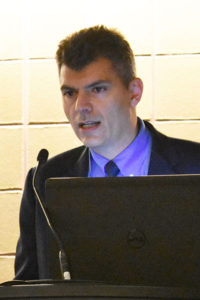
When it comes to patient care, clinicians around the globe would agree that practicing evidence-based medicine is ideal. Unfortunately, as CHEST Guidelines Oversight Committee Chair Kevin O’Neil, MD, MHA, FCCP, said, there’s a problem with evidence-based medicine.
The problem is physicians can’t keep up with the literature, and no individual has the time or expertise to synthesize the available data to answer every clinical question, he said. This is why clinical practice guidelines are needed.
Dr. O’Neil made this argument as an introduction to the CHEST Clinical Practice Guidelines Update session on Monday afternoon. The session included brief updates on the status of four clinical practice guidelines, including a review of CHEST’s Screening for Lung Cancer guideline, which was presented by new CHEST® Editor in Chief Peter Mazzone, MD, FCCP.
The guideline was accepted for publication about 2 years ago, but as a “living guideline,” CHEST has committed to a review model that allows for more flexible and timely updating compared to traditional methods of updating guidelines.
“With the living guidelines model, periodically we’re reviewing the evidence, and when the evidence rises to a level where we need to revise our recommendations, we’re prepared to do so, rather than waiting,” Dr. Mazzone said.
The current guidelines have six recommendations and nine consensus-based statements.
“CHEST guidance allows us to make statements where the evidence isn’t strong enough for a recommendation, but where practice guidance is helpful,” he said. “We also can make remarks about any of the recommendations, which help us explain why we made particular recommendations.”
Dr. Mazzone reviewed some of the recommendations in the lung cancer screening guideline, including a quick review of the evidence base used to make the recommendations. He also briefly highlighted two studies that may change the recommendations in the future.
Next, Scott Woller, MD, FCCP, Co-chair of the CHEST Antithrombotic Therapy Committee for Venous Thrombosis Treatment, discussed how the living guideline methodology would be adopted for CHEST’s Antithrombotic Therapy for VTE Disease, which came out in early 2016.
“CHEST continues to be committed to leading and providing guidance surrounding antithrombotic therapy for patients with venous thromboembolic disease,” Dr. Woller said. “To embrace best practices, we’ve committed to a predetermined search methodology and frequency. We’re interested in providing an assessment of recommendations at intervals so that when new evidence becomes available, it can be incorporated. And we will update individual recommendations when indicated, so that the unit of update is the recommendation—not the whole guideline.”
Dr. Woller then outlined the guideline questions that have been elected for update as well as three newly identified questions for recommendations. The newly identified questions:
- Reduced-dose vs full-dose anticoagulation for extended treatment of VTE
- Direct-acting oral anticoagulants in patients with antiphospholipid syndrome
- Whether to treat cerebral vein thrombosis
The session also included an update on an anticipated guideline on cryobiopsy in the treatment of interstitial lung disease by Lonny Yarmus, DO, FCCP, associate professor of medicine at Johns Hopkins Medicine. Finally, David Badesch, MD, FCCP, professor of medicine at the University of Colorado School of Medicine, provided an update on the PAH guidelines.
Screening for Lung Cancer Recommendations
During Monday’s Clinical Practice Guidelines Update session new CHEST® Editor in Chief Peter Mazzone, MD, FCCP, discussed the review process for the organization’s “living guidelines” and shared recommendations from the CHEST Screening for Lung Cancer. Please refer to the guideline and expert panel report for the complete recommendations with their remarks and consensus statements.
- For asymptomatic smokers and former smokers age 55 to 77 who have smoked 30 pack years or more and either continue to smoke or have quit within the past 15 years, we suggest that annual screening with low-dose CT should be offered.
- For asymptomatic smokers and former smokers who do not meet the smoking and age criteria in Recommendation No. 1, but are deemed to be at high risk of having/developing lung cancer based on clinical risk prediction calculators, we suggest that low-dose CT screening should not be routinely performed.
- For individuals who have accumulated fewer than 30 pack years of smoking or are younger than age 55 or older than 77, or have quit smoking more than 15 years ago, and do not have a high risk of having/developing lung cancer based on clinical risk prediction calculators, we recommend that low-dose CT screening should not be performed.
- For individuals with comorbidities that adversely influence their ability to tolerate the evaluation of screen-detected findings or tolerate treatment of an early stage screen-detected lung cancer, or that substantially limit their life expectancy, we recommend that low-dose CT screening should not be performed.





